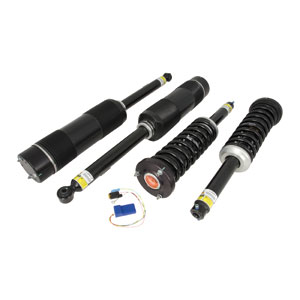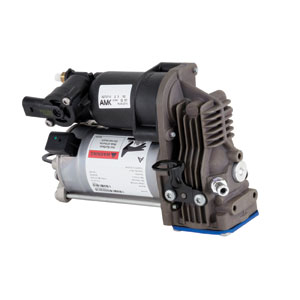A step-by-step guide from Arnott Europe on air spring and compressor fitment.
 Air suspension is becoming increasingly popular, with more and more cars now equipped with this type of system. On average air springs should be replaced very 6-10 years due to age and issues caused by general wear and tear
Air suspension is becoming increasingly popular, with more and more cars now equipped with this type of system. On average air springs should be replaced very 6-10 years due to age and issues caused by general wear and tear
Driving too long with worn-out air springs can also increase the risk of a failing compressor. If this is the case then both the air springs and compressor should be replaced at the same time.
Dealer or no dealer?
So if your customer comes to you with an air suspension system problem, how do you deal with it? Traditionally workshops would either have to send their customer off to the franchised repairer for the repair or would have to purchase the required replacement components directly from the dealer at an expensive price.
Designed, produced or assembled in the USA, Arnott’s products can help installers to overcome this issue as they’re only available to the aftermarket and are considerably lower priced than the OE parts. Its range contains compressors, air struts, shocks, air springs and coil conversion kits for most vehicles with air suspension systems.
The company not only manufactures new components, but it can also deliver remanufactured air struts as well. It works with a core deposit system for remanufactured products and will also purchase old air struts; when there is a core deposit on the remanufactured struts, Arnott will inform the customer and ask them to return the old core.
If the parts cannot be used they’re then discarded responsibly. No concessions are made on quality, that’s why Arnott Europe offers a limited lifetime warranty on air springs, air struts, shock absorbers and conversion kits for European customers. Compressors come with a limited two-year warranty
Fitting focus
Replacing the components is a straightforward process as they’re essentially ‘plug-and-play’. Furthermore, the original components can be replaced with Arnott’s products without the need for any adaptations to the airlines, mounting points or the chassis.
Automotive technicians are given further support with installing air suspension systems through a selection of installation manuals and videos that can be found at: www.arnottmanuals.com.
Step 1 Firstly, it’s important to ascertain what the customer’s complaints are; in 90% of cases a MIL is lit on the dashboard and the driver will complain that the car isn’t levelled or is no longer levelling to the correct driving height. A leak can be difficult to find. Sometimes the rubber pushes the cracks shut and the air pring doesn’t appear to be leaking. It is, therefore, important to test the vehicle for possible leakages at every individual driving height.

Step 2 You should then diagnose the problem using a suitable diagnostic tool.Do the fault codes relate to the failure? Reset the system and start the car. Then check if the system is activated and whether the compressor is functioning.

Step 3 Is the compressor working and is the pressure back in the air suspension system? If so then you can look for the cause. The problem could be in the height sensors, air springs, pipes or in the valves. Air springs, in particular, are subject to a good deal of wear and tear; the area where the air spring bends can dry out, causing small cracks. Leakages will then develop or appear (on average) after 6-10 years. For this reason you should check whether there are air leaks, using soap if needed. Some vehicles have torn air pipes or the height sensor axes are broken. To test the compressor you can connect it to a diagnostic unit. Is the compressor working, but there is no pressure in the system? If so then this likely means that the compressor output is too low. Replace the compressor and find out why it is defective.

Step 4 When the compressor isn’t working it’s usually because of a leakage in the system. If there is leakage the compressor has to continuously pump air into the system. It is not made for that and sooner or later the compressor will stop functioning. Before you replace the compressor, check the fuses and relays. Is the compressor receiving power?

Step 5 The compressor is usually attached with a few bolts. Disconnect the airlines and connectors and replace the compressor. Arnott Europe says that you should also always replace the air suspension relay. When a relay is faulty the compressor is either working constantly or not working at all. Warrantywise it is necessary to replace the relay when you install a new compressor.

Step 6 Disconnect the old air springs and disassemble them. Don’t throw the old air struts away – these are still worth money! Instead you should them back to Arnott Europe.

Step 7 Read the installation manual and place the new air springs/struts. Check if the connections are clean and connect the airlines.

Step 8 Use a jack to support the car, so that the air springs aren’t under pressure and folded. Start the engine, wait for a couple of minutes and check if the air springs are inflated. Lower the car’s suspension slowly. The system should be maintaining the correct pressure.










